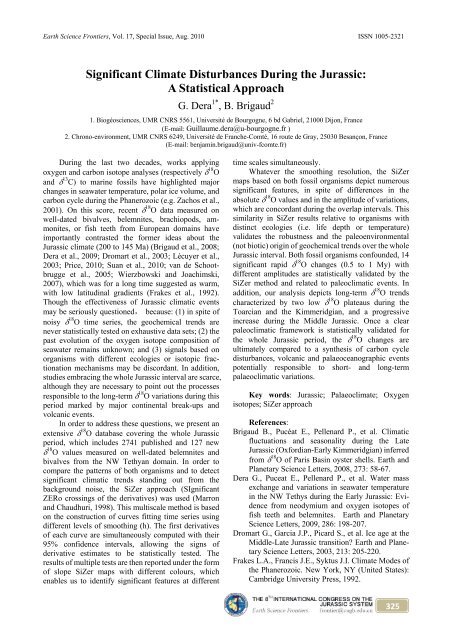in Jurassic and Cretaceous Stratigraphy
in Jurassic and Cretaceous Stratigraphy
in Jurassic and Cretaceous Stratigraphy
You also want an ePaper? Increase the reach of your titles
YUMPU automatically turns print PDFs into web optimized ePapers that Google loves.
Earth Science Frontiers, Vol. 17, Special Issue, Aug. 2010 ISSN 1005-2321<br />
Significant Climate Disturbances Dur<strong>in</strong>g the <strong>Jurassic</strong>:<br />
A Statistical Approach<br />
G. Dera 1* , B. Brigaud 2<br />
1. Biogéosciences, UMR CNRS 5561, Université de Bourgogne, 6 bd Gabriel, 21000 Dijon, France<br />
(E-mail: Guillaume.dera@u-bourgogne.fr )<br />
2. Chrono-environment, UMR CNRS 6249, Université de Franche-Comté, 16 route de Gray, 25030 Besançon, France<br />
(E-mail: benjam<strong>in</strong>.brigaud@univ-fcomte.fr)<br />
Dur<strong>in</strong>g the last two decades, works apply<strong>in</strong>g<br />
oxygen <strong>and</strong> carbon isotope analyses (respectively 18 O<br />
<strong>and</strong> 13 C) to mar<strong>in</strong>e fossils have highlighted major<br />
changes <strong>in</strong> seawater temperature, polar ice volume, <strong>and</strong><br />
carbon cycle dur<strong>in</strong>g the Phanerozoic (e.g. Zachos et al.,<br />
2001). On this score, recent 18 O data measured on<br />
well-dated bivalves, belemnites, brachiopods, am-<br />
monites, or fish teeth from European doma<strong>in</strong>s have<br />
importantly contrasted the former ideas about the<br />
<strong>Jurassic</strong> climate (200 to 145 Ma) (Brigaud et al., 2008;<br />
Dera et al., 2009; Dromart et al., 2003; Lécuyer et al.,<br />
2003; Price, 2010; Suan et al., 2010; van de Schoot-<br />
brugge et al., 2005; Wierzbowski <strong>and</strong> Joachimski,<br />
2007), which was for a long time suggested as warm,<br />
with low latitud<strong>in</strong>al gradients (Frakes et al., 1992).<br />
Though the effectiveness of <strong>Jurassic</strong> climatic events<br />
may be seriously questioned, because: (1) <strong>in</strong> spite of<br />
noisy 18 O time series, the geochemical trends are<br />
never statistically tested on exhaustive data sets; (2) the<br />
past evolution of the oxygen isotope composition of<br />
seawater rema<strong>in</strong>s unknown; <strong>and</strong> (3) signals based on<br />
organisms with different ecologies or isotopic frac-<br />
tionation mechanisms may be discordant. In addition,<br />
studies embrac<strong>in</strong>g the whole <strong>Jurassic</strong> <strong>in</strong>terval are scarce,<br />
although they are necessary to po<strong>in</strong>t out the processes<br />
responsible to the long-term 18 O variations dur<strong>in</strong>g this<br />
period marked by major cont<strong>in</strong>ental break-ups <strong>and</strong><br />
volcanic events.<br />
In order to address these questions, we present an<br />
extensive 18 O database cover<strong>in</strong>g the whole <strong>Jurassic</strong><br />
period, which <strong>in</strong>cludes 2741 published <strong>and</strong> 127 new<br />
18 O values measured on well-dated belemnites <strong>and</strong><br />
bivalves from the NW Tethyan doma<strong>in</strong>. In order to<br />
compare the patterns of both organisms <strong>and</strong> to detect<br />
significant climatic trends st<strong>and</strong><strong>in</strong>g out from the<br />
background noise, the SiZer approach (SIgnificant<br />
ZERo cross<strong>in</strong>gs of the derivatives) was used (Marron<br />
<strong>and</strong> Chaudhuri, 1998). This multiscale method is based<br />
on the construction of curves fitt<strong>in</strong>g time series us<strong>in</strong>g<br />
different levels of smooth<strong>in</strong>g (h). The first derivatives<br />
of each curve are simultaneously computed with their<br />
95% confidence <strong>in</strong>tervals, allow<strong>in</strong>g the signs of<br />
derivative estimates to be statistically tested. The<br />
results of multiple tests are then reported under the form<br />
of slope SiZer maps with different colours, which<br />
enables us to identify significant features at different<br />
time scales simultaneously.<br />
Whatever the smooth<strong>in</strong>g resolution, the SiZer<br />
maps based on both fossil organisms depict numerous<br />
significant features, <strong>in</strong> spite of differences <strong>in</strong> the<br />
absolute 18 O values <strong>and</strong> <strong>in</strong> the amplitude of variations,<br />
which are concordant dur<strong>in</strong>g the overlap <strong>in</strong>tervals. This<br />
similarity <strong>in</strong> SiZer results relative to organisms with<br />
dist<strong>in</strong>ct ecologies (i.e. life depth or temperature)<br />
validates the robustness <strong>and</strong> the paleoenvironmental<br />
(not biotic) orig<strong>in</strong> of geochemical trends over the whole<br />
<strong>Jurassic</strong> <strong>in</strong>terval. Both fossil organisms confounded, 14<br />
significant rapid 18 O changes (0.5 to 1 My) with<br />
different amplitudes are statistically validated by the<br />
SiZer method <strong>and</strong> related to paleoclimatic events. In<br />
addition, our analysis depicts long-term 18 O trends<br />
characterized by two low 18 O plateaus dur<strong>in</strong>g the<br />
Toarcian <strong>and</strong> the Kimmeridgian, <strong>and</strong> a progressive<br />
<strong>in</strong>crease dur<strong>in</strong>g the Middle <strong>Jurassic</strong>. Once a clear<br />
paleoclimatic framework is statistically validated for<br />
the whole <strong>Jurassic</strong> period, the 18 O changes are<br />
ultimately compared to a synthesis of carbon cycle<br />
disturbances, volcanic <strong>and</strong> palaeoceanographic events<br />
potentially responsible to short- <strong>and</strong> long-term<br />
palaeoclimatic variations.<br />
Key words: <strong>Jurassic</strong>; Palaeoclimate; Oxygen<br />
isotopes; SiZer approach<br />
References:<br />
Brigaud B., Pucéat E., Pellenard P., et al. Climatic<br />
fluctuations <strong>and</strong> seasonality dur<strong>in</strong>g the Late<br />
<strong>Jurassic</strong> (Oxfordian-Early Kimmeridgian) <strong>in</strong>ferred<br />
from 18 O of Paris Bas<strong>in</strong> oyster shells. Earth <strong>and</strong><br />
Planetary Science Letters, 2008, 273: 58-67.<br />
Dera G., Puceat E., Pellenard P., et al. Water mass<br />
exchange <strong>and</strong> variations <strong>in</strong> seawater temperature<br />
<strong>in</strong> the NW Tethys dur<strong>in</strong>g the Early <strong>Jurassic</strong>: Evi-<br />
dence from neodymium <strong>and</strong> oxygen isotopes of<br />
fish teeth <strong>and</strong> belemnites. Earth <strong>and</strong> Planetary<br />
Science Letters, 2009, 286: 198-207.<br />
Dromart G., Garcia J.P., Picard S., et al. Ice age at the<br />
Middle-Late <strong>Jurassic</strong> transition? Earth <strong>and</strong> Plane-<br />
tary Science Letters, 2003, 213: 205-220.<br />
Frakes L.A., Francis J.E., Syktus J.I. Climate Modes of<br />
the Phanerozoic. New York, NY (United States):<br />
Cambridge University Press, 1992.<br />
325

















